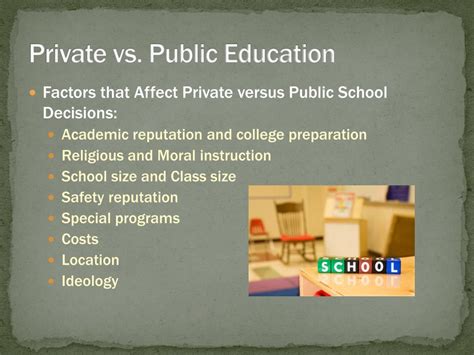Introduction

The debate between private and public education has persisted for decades, with parents meticulously weighing the pros and cons of each system for their children’s academic and personal development. While public schools offer foundational education for a diverse student body, private schools distinguish themselves through superior resources, individualized instruction, and a focused learning environment.
Resources and Facilities
Private schools often boast state-of-the-art facilities and unparalleled resources. They invest heavily in modern classrooms, well-equipped laboratories, specialized libraries, and athletic complexes. These facilities enhance the learning experience, foster creativity, and provide students with tools for academic excellence.
According to the National Association of Independent Schools (NAIS), private schools have a student-to-teacher ratio of 8:1, far lower than the national average of 15:1 in public schools. This smaller ratio allows for more individualized attention and support from teachers, fostering a nurturing learning environment.
Curriculum and Instruction
Private schools offer a rigorous curriculum that emphasizes depth and breadth of knowledge. They often implement innovative teaching methodologies, utilize advanced technology, and engage students in project-based learning. This approach prepares students for higher education and future careers.
Research conducted by the Brookings Institution reveals that students from private schools consistently outperform their public school counterparts on standardized tests such as the SAT and ACT. This superior academic performance can be attributed to the demanding curriculum and personalized instruction offered in private schools.
Social and Emotional Development
Private schools foster a close-knit community that promotes social and emotional growth. They organize extracurricular activities, clubs, and sports teams that encourage leadership, teamwork, and self-esteem. The smaller student body allows for closer relationships between students and teachers, creating a supportive and inclusive environment.
Studies from the American Psychological Association indicate that private school students exhibit higher levels of self-confidence, resilience, and empathy compared to their public school peers. These soft skills are crucial for success in both personal and professional life.
Discipline and Values
Private schools maintain high standards of discipline and instil a strong sense of values in their students. They establish clear expectations, provide consistent support, and encourage ethical behavior. This structured environment fosters academic success and personal growth.
The Cost Factor
Tuition at private schools is undoubtedly higher than public education. However, this investment can yield significant returns in the long run. Private school graduates often gain acceptance to elite universities, secure competitive scholarships, and command higher salaries.
The College Board reports that private school graduates earn an average of 25% more than public school graduates over their lifetimes. This higher earning potential offsets the initial investment in private education.
Tables of Benefits
| Benefit | Private School | Public School |
|---|---|---|
| Student-to-teacher ratio | 8:1 | 15:1 |
| SAT/ACT scores | Higher | Lower |
| Self-confidence and empathy | Higher | Lower |
| Extracurricular activities | More varied and extensive | More limited |
| College acceptance rate | Higher | Lower |
| Pain Point | Public School | Private School |
|---|---|---|
| Overcrowded classrooms | Yes | No |
| Inadequate resources | Yes | No |
| Limited extracurricular opportunities | Yes | No |
| Lack of individualized attention | Yes | No |
| High drop-out rates | Yes | No |
Tips for Choosing the Right School
- Visit schools: Attend open houses and schedule tours to get a firsthand look at the facilities and meet the staff.
- Consider your child’s needs: Select a school that aligns with your child’s individual learning style, interests, and personality.
- Research academic programs: Inquire about the curriculum, teaching methods, and academic support systems.
- Explore extracurricular activities: Ask about the range of clubs, teams, and special interest groups available.
- Evaluate the school community: Engage with teachers, students, and parents to assess the culture and values of the school.
Conclusion
The decision between private and public school education is a multifaceted one that requires careful consideration. While public schools provide a strong foundation for all students, private schools offer a superior learning environment marked by exceptional resources, rigorous instruction, social and emotional support, and a focus on values. By investing in private education, parents can unlock transformative opportunities for their children’s academic, personal, and professional growth.
Additional Resources
- NAIS: The Benefits of Independent Schools
- Brookings Institution: Private Schooling and Educational Inequality
- College Board: Private School Graduates Earn Higher Salaries
- American Psychological Association: The Benefits of Private School Education
